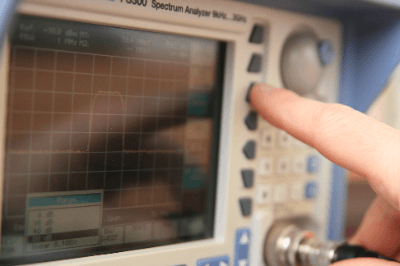What Is a Signal Analyzer?
 A signal analyzer is a signal measurement, evaluation, and analysis instrument that can detect even signals with complex modulation.
A signal analyzer is a signal measurement, evaluation, and analysis instrument that can detect even signals with complex modulation.
It can measure the amplitude versus frequency of an incoming signal over the entire frequency range of the instrument and the spectrum strength of known or unknown signals. It can also measure the amplitude and phase of an input signal at a single frequency within the instrument’s intermediate frequency (IF) bandwidth.
In addition to frequency domain spectrum measurements, signal analyzers are capable of advanced time domain analysis. The modulation quality of complex digitally modulated signals, such as cellular phones, can be analyzed using sophisticated signal analysis processing.
Uses of Signal Analyzers
Signal analyzers are used for frequency spectrum analysis, time-based signal analysis, and the evaluation of modulation signal quality.
1. Frequency Spectrum Analysis
Signal analyzers are used for frequency spectrum analysis. It is especially useful for evaluating ACLR (adjacent channel leakage power), which expresses signal distortion of digitally modulated waveforms.
Applications include testing RF characteristics of terminals and transmitting machines in digital radio systems. Specifically, they include carrier frequency, channel bandwidth, channel power, occupied bandwidth, and adjacent channel leakage power ratio.
In addition, it can measure spurious and harmonics over a wide frequency range from an RF band to a microwave band, which is a major feature of superheterodyne spectrum analyzers.
2. Time-Based Signal Analysis
Signal analyzers are also used for time-based signal analysis. The input RF signal is converted to a digital IQ data format, captured, and processed digitally at a high speed.
Therefore, it is effective for analyzing the PvT (Power vs. Time) waveform of each slot in 5G modulation.
3. Modulation Quality of Digitally Modulated Signals
A signal analyzer is also used for evaluation of modulation accuracy EVM and CCDF (complementary cumulative distribution function) evaluation analysis, which are familiar in the world of mobile communications.
In addition to spectrum characteristics, the modulation quality of digitally modulated signals used in communication systems must be measured to maintain stable communication conditions. In this respect, signal analyzers can also measure the modulation quality of digitally modulated signals by combining it with various vector analysis applications.
Signal Analyzer Principle
The signal analyzer captures the memory of the measured signal for a certain amount of time, with only the frequency of the signal converted. Then, the system obtains analysis results through the steps of “digitizing and storing,” “converting frequency,” and “converting to spectrum, etc.”
First, the measurement signal entering the input section of the Signal Analyzer is converted to an intermediate frequency (IF) in the frequency conversion section. Next, the IF-converted measurement signal is converted to digital data. The digitized time-series waveform data is then immediately captured into the internal memory. This data can also be stored separately on a hard disk.
Signal analyzers have the advantage of high-speed processing and high repeatability. It is suitable for analysis and analysis of high-resolution standards such as millimeter wave (wavelength range from 1 to 10 mm) and sub-millimeter wave (wavelength range from 0.1 to 1 mm).
Other Information on Signal Analyzers
1. The Difference Between a Signal Analyzer and a Spectrum Analyzer
Signal Analyzer is a spectrum analyzer capable of analyzing modulated signals. Specifically, Signal Analyzers are very advanced in time-based signal measurement and analysis.
Signal analyzers have unique signal processing techniques that spectrum analyzers do not have. In addition to the superheterodyne method, this method uses a high-speed A/D converter to convert the signal to a digital signal, load the data into memory, and perform a high-speed Fourier transform.
This method enables analysis of recent digital modulation waveforms such as LTE and 5G, which have complex time response components and cannot be analyzed with conventional spectrum analyzers due to time response limitations.
2. Signal Analyzer Price
Signal analyzers tend to be priced in a wide range because the internal memory and digital processing power required for analysis vary greatly depending on the supported functions and frequency range.